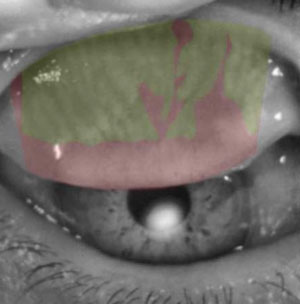 |
Q: I have a 22-year-old patient who is now a grad student with a history of LASIK, performed two years prior. She still needs glasses and her eyes are constantly hurting her. She is on frequent tear replacement therapy and Restasis but reports no improvement. How can I help her?
A: “Graduate students have demanding workloads in terms of reading,” says Justin Kwan, OD, of Southern California College of Optometry. LASIK can disrupt binocular vision and manifest as dry eye symptoms, so investigate the integrity of the binocular vision and accommodation systems before meibomian gland evaluation, he says.
Dominick Opitz, OD, of Illinois College of Optometry (ICO) adds that many patients pursue LASIK due to contact lens (CL) intolerance. “Several studies show a relationship between CL wear MGD, so certainly evaluate the quality and quantity of MG secretions.”
 | |
| Meibography shows Grade 2 meibomian gland dysfunction. |
Dr. Opitz’s colleague at ICO, Jennifer Harthan, OD, agrees. “Pay close attention to the lids for signs of active MGD,” Dr. Harthan says. “Also, look for cylindrical dandruff, indicating Demodex” involvement in lid disease. Leslie O’Dell, OD, director of the Dry Eye Center of Pennsylvania at Wheatlyn Eye Care, says MG expression helps determine MGD severity. Dr. Optiz adds that “if the patient suffers from aqueous-deficient dry eye pre-LASIK, this is likely to be exacerbated [by the surgery].” Studies suggest patients rarely suffer from only one subtype of ocular surface disease. Both aqueous-deficient and evaporative dry eye tend to be present.
Questionnaires—and Answers
“For this patient, start with a dry eye questionnaire,” says Dr. O’Dell. The Standard Patient Evaluation of Eye Dryness (SPEED) survey is great because it is both fast and validated, but the Ocular Surface Disease Index (OSDI) is being used again thanks to free new app, the Dry Eye OSDI Questionnaire, she says.
“Questionnaires will be helpful in quantifying the patient’s symptoms and their response to treatment,” says Dr. Opitz.
According to Dr. O’Dell, treatment would really depend on the exam. “If there is no inflammation present and the meibomian glands are healthy, consider punctal occlusion in addition to Restasis (Allergan). If inflammation and MGD are identified, use at-home lid debridement followed by 10 minutes of warm compresses,” she says.
| Is it Sjögren’s? “Patients with aqueous-deficient dry eye with or without MGD should be evaluated for autoimmune disease like Sjögren’s,” notes Dr. Optiz. Dr. O’Dell points out that the presence of dry mouth helps uncover the potential for systemic involvement. “We recently did a study showing a high correlation between dry eyes and dry mouth in 563 patients,” she says.1 Dr. Harthan says to consider blood work for an autoimmune component and perform in-office Sjö testing for Sjögren’s. Studies suggest testing may allow for earlier detection of Sjögren’s, Dr. Optiz says. |
Dr. Opitz recommends adjunctive therapies to reduce inflammation. “Whether the diagnosis is aqueous, evaporative or both, consider using anti-inflammatory medications with Restasis, like omega 3s, Lotemax gel (Bausch + Lomb), as well as oral or topical azithromycin,” he says.
“This patient will likely need eyelid margin debridement scaling, in-office forced expression with the Mastrota paddle and oral azithromycin to kick-start her meibomian glands,” says Dr. Kwan. “Omega-3 supplementation and Retaine MGD ophthalmic emulsion (Ocusoft) may help.”
Dr. O’Dell recommends in-office MG expression. “Of course, if Demodex is identified, treatment is crucial to symptom relief.”
